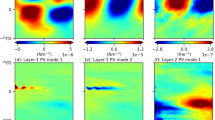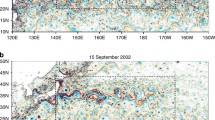Abstract
The problem of numerical modeling and analysis of the large-scale World Ocean circulation variability under variations of the external forcing is considered. A numerical model was developed in the INM RAS and is based on the primitive equations of the ocean circulation written in a spherical generalized σ-coordinate system. The model’s equations are approximated on a grid with resolution of 2.5° × 2° × 33, and the North Pole is displaced to the continental point (60°E, 60.5°N). There are two stages for the numerical experiments. The quasi-equilibrium circulation of the World Ocean under the climatological atmospheric forcing is simulated at the first stage. The run is carried out over a period of 3000 years during which a quasi-equilibrium model regime is formed. At the second stage, the sensitivity of the model ocean circulation to the atmospheric forcing perturbations in the Southern Hemisphere is studied. According to the results, the strongest regional changes in the hydrography take place in the Arctic Ocean. Substantial changes of sea’s surface height and local anomalies of the temperature and salinity are formed there.
Similar content being viewed by others
References
G. V. Alekseev, I. E. Frolov, and V. T. Sokolov, “Observations in the Arctic Do not Confirm the Weakening of the Thermohaline Circulation in the North Atlantic,” Dokl. Akad. Nauk 413(2), 277–280 (2007).
E. M. Volodin and N. A. Diansky, “Simulation of Climate Changes in the 20th–22nd Centuries with a Coupled Atmosphere-Ocean General Circulation Model,” Izv. Akad. Nauk, Fiz. Atmos. Okeana 42(3), 291–306 (2006) [Izv., Atmos. Ocean. Phys. 42 (3), 267–281 (2006)].
V. B. Zalesny and V. O. Ivchenko, “Influence of Anomalous Regimes in the Southern Ocean on Equatorial Dynamics,” Izv. Akad. Nauk, Fiz. Atmos. Okeana 41(3), 341–359 (2005) [Izv., Atmos. Ocean. Phys. 41 (3), 308–324 (2005)].
V. M. Koshlyakov, A. A. Romanov, and Yu. A. Romanov, “El Niño-Southern Oscillation and the Iceberg Distribution in the Pacific Sector of the Antarctic,” Okeanologiya 38(4), 485–495 (1998) [Oceanology 38 (4), 437–446 (1998)].
G. I. Marchuk, Methods of Numerical Mathematics, 2nd ed. (Nauka, Moscow, 1980; Springer, New York, 1975).
G. I. Marchuk, Splitting Methods (Nauka, Moscow, 1988) [in Russian].
A. S. Sarkisyan, Numerical Analysis and Forecast of Marine Currents (Gidrometeoizdat, Leningrad, 1977) [in Russian].
E. V. Semenov, “Numerical Modeling of White Sea Dynamics and Monitoring Problem,” Izv. RAN. Fiz. Atm. I Okeana 40(1), 128–141 (2004) [Izv., Atmos. Ocean. Phys. 40 (1), 114–126 (2004)].
E. V. Semenov, “Status and Development of Hydrodynamic Models of the Ocean,” Fundam. Prikl. Gidrofiz., No. 1, 12–28 (2008).
N. G. Yakovlev, “Coupled Model of Ocean General Circulation and Sea Ice Evolution in the Arctic Ocean,” Izv. Akad. Nauk, Fiz. Atmos. Okeana 39(3), 394–409 (2003) [Izv., Atmos. Ocean. Phys. 39 (3), 355–368 (2003)].
V. I. Agoshkov, E. I. Parmuzin, and V. P. Shutyaev, “A Numerical Algorithm of Variational Data Assimilation for Reconstruction of Salinity Fluxes on the Ocean Surface,” Russ. J. Numer. Anal. Math. Modeling 23(2), 135–161 (2008).
A. T. Blaker, B. Sinha, V. O. Ivchenko, et al., “Identifying Roles of the Ocean and Atmosphere in the Creating a Rapid Equatorial Response to a Perturbation in the Southern Ocean,” Geophys. Rev. Lett. 33, L06720, doi: 10.1029/2005GL025474 (2006).
F. Castruccio, J. Verron, L. Gourdeau, et al., “Joint Altimetric and In-Situ Data Assimilation Using the GRACE Mean Dynamic Topography: A 1993–1998 Hindcast Experiment in the Tropical Pacific Ocean,” Ocean Dynamics 58, 43–63 (2008).
S. M. Griffies, Ocean Weather Forecasting: An Integrated View of Oceanography, Ed. by E. P. Chassignet and J. Verron (Springer, Berlin, Germany, 2005), pp. 19–74.
S. M. Griffies, M. Winton, and B. L. Samuels, The Large and Yeager (2004) Dataset and CORE, NOAA Geophysical Fluid Dynamics Laboratory PO Box 308, Forrestal Campus, 08542 USA, Princeton, New Jersey (2004).
V. O. Ivchenko, V. B. Zalesny, and M. R. Drinkwater, “Can the Equatorial Ocean Quickly Respond to Antarctic Sea Ice/Salinity Anomalies?,” Geophys. Rev. Lett. 31, L15310, doi: 10.1029/2004 GL020472 (2004).
V. O. Ivchenko, V. B. Zalesny, M. Drinkwater, and J. Schroeter, “A Quick Response of the Equatorial Ocean to Antarctic Sea Ice/Salinity Anomalies,” J. Geophys. Res. 111, C10018, doi: 10.1029/2005JC003061 (2006).
R. Kwok and J. C. Comiso, “Southern Ocean Climate and Sea Ice Anomalies Associated with the Southern Oscillation,” J. Clim. 15, 487–501 (2002).
S. Levitus, T. P. Boyer, M. E. Conkright, et al., World Ocean Database 1998, NOAA Atlas NESDIS 18 (1998).
G. I. Marchuk, J. Schroeter, and V. B. Zalesny, “Numerical Study of the Global Ocean Equilibrium Circulation,” Russ. J. Numer. Anal. Math. Modelling 18(4), 307–335 (2003).
S. N. Moshonkin, A. V. Bagno, A. V. Gusev, and N. A. Diansky, “Numerical Modelling of Oceanic Circulation and Sea Ice in the North Atlantic-Arctic Ocean-Bering Sea Region,” Russ. J. Numer. Anal. Math. Modelling 21(4), 421–443 (2006).
R. G. Peterson and W. B. White, “Slow Teleconnections Linking the Antarctic Circumpolar Wave with the Tropical El Niño-Southern Oscillation,” J. Geophys. Res. 103(C11), 24573–24583 (1998).
G. M. Reznik and V. Zeitlin, “Resonant Exitation of Coastal Kelvin Waves by Inertia-Gravity Waves,” Physics Letters. A, doi: 10.1016/J.physleta.2009.01.040.
V. B. Zalesny and A. V. Gusev, “Mathematical Model of the World Ocean Dynamics with Temperature and Salinity Variational Data Assimilation Algorithms,” Russ. J. Numer. Anal. Math. Modelling 24(2), 171–191 (2009).
Author information
Authors and Affiliations
Corresponding author
Additional information
Original Russian Text © V.B. Zalesny, V.O. Ivchenko, 2010, published in Okeanologiya, 2010, Vol. 50, No. 6, pp. 877–889.
Rights and permissions
About this article
Cite this article
Zalesny, V.B., Ivchenko, V.O. Modeling the global circulation response and the regional response of the Arctic Ocean to the external forcing anomalies. Oceanology 50, 829–840 (2010). https://doi.org/10.1134/S0001437010060020
Received:
Accepted:
Published:
Issue Date:
DOI: https://doi.org/10.1134/S0001437010060020




